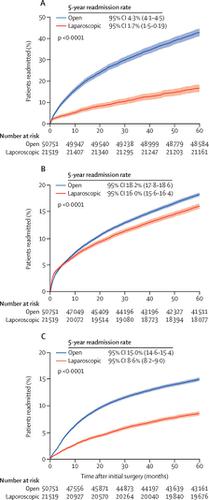Our official English website, www.x-mol.net, welcomes your feedback! (Note: you will need to create a separate account there.)
Adhesion-related readmissions after open and laparoscopic surgery: a retrospective cohort study (SCAR update).
The Lancet ( IF 168.9 ) Pub Date : 2020-01-04 , DOI: 10.1016/s0140-6736(19)32636-4 Pepijn Krielen 1 , Martijn W J Stommel 1 , Pille Pargmae 2 , Nicole D Bouvy 3 , Erica A Bakkum 4 , Harold Ellis 5 , Michael C Parker 6 , Ewen A Griffiths 7 , Harry van Goor 1 , Richard P G Ten Broek 1
The Lancet ( IF 168.9 ) Pub Date : 2020-01-04 , DOI: 10.1016/s0140-6736(19)32636-4 Pepijn Krielen 1 , Martijn W J Stommel 1 , Pille Pargmae 2 , Nicole D Bouvy 3 , Erica A Bakkum 4 , Harold Ellis 5 , Michael C Parker 6 , Ewen A Griffiths 7 , Harry van Goor 1 , Richard P G Ten Broek 1
Affiliation

|
BACKGROUND
Adhesions are the most common driver of long-term morbidity after abdominal surgery. Although laparoscopy can reduce adhesion formation, the effect of minimally invasive surgery on long-term adhesion-related morbidity remains unknown. We aimed to assess the impact of laparoscopy on adhesion-related readmissions in a population-based cohort.
METHODS
We did a retrospective cohort study of patients of any age who had abdominal or pelvic surgery done using laparoscopic or open approaches between June 1, 2009, and June 30, 2011, using validated population data from the Scottish National Health Service. All patients who had surgery were followed up until Dec 31, 2017. The primary outcome measure was the incidence of hospital readmissions directly related to adhesions in the laparoscopic and open surgery cohorts at 5 years. Readmissions were categorised as directly related to adhesions, possibly related to adhesions, and readmissions for an operation that was potentially complicated by adhesions. We did subgroup analyses of readmissions by anatomical site of surgery and used Kaplan-Meier analyses to assess differences in survival across subgroups. We used multivariable Cox-regression analysis to determine whether surgical approach was an independent and significant risk factor for adhesion-related readmissions.
FINDINGS
Between June 1, 2009, and June 30, 2011, 72 270 patients had an index abdominal or pelvic surgery, of whom 21 519 (29·8%) had laparoscopic index surgery and 50 751 (70·2%) had open surgery. Of the 72 270 patients who had surgery, 2527 patients (3·5%) were readmitted within 5 years of surgery for disorders directly related to adhesions, 12 687 (17·6%) for disorders possibly related to adhesions, and 9436 (13·1%) for operations potentially complicated by adhesions. Of the 21 519 patients who had laparoscopic surgery, 359 (1·7% [95% CI 1·5-1·9]) were readmitted for disorders directly related to adhesions compared with 2168 (4·3% [4·1-4·5]) of 50 751 patients in the open surgery cohort (p<0·0001). 3443 (16·0% [15·6-16·4]) of 21 519 patients in the laparoscopic surgery cohort were readmitted for disorders possibly related to adhesions compared with 9244 (18·2% [17·8-18·6]) of 50 751 patients in the open surgery cohort (p<0·005). In multivariate analyses, laparoscopy reduced the risk of directly related readmissions by 32% (hazard ratio [HR] 0·68, 95% CI 0·60-0·77), and of possibly related readmissions by 11% (HR 0·89, 0·85-0·94) compared with open surgery. Procedure type, malignancy, sex, and age were also independently associated with risk of adhesion-related readmissions.
INTERPRETATION
Laparoscopic surgery reduces the incidence of adhesion-related readmissions. However, the overall burden of readmissions associated with adhesions remains high. With further increases in the use of laparoscopic surgery expected in the future, the effect at the population level might become larger. Further steps remain necessary to reduce the incidence of adhesion-related postsurgical complications.
FUNDING
Dutch Adhesion Group and Nordic Pharma.
中文翻译:

开放和腹腔镜手术后与粘附有关的再入院:一项回顾性队列研究(SCAR更新)。
背景技术粘连是腹部手术后长期发病的最常见驱动因素。尽管腹腔镜检查可以减少粘连形成,但是微创手术对长期粘连相关发病率的影响仍然未知。我们旨在评估腹腔镜检查对以人群为基础的队列中粘附相关的再入院的影响。方法我们采用苏格兰国家卫生局(Scottish National Health Service)的经过验证的人口数据,对2009年6月1日至2011年6月30日期间使用腹腔镜或开放式方法进行腹部或骨盆手术的任何年龄的患者进行了回顾性队列研究。所有接受手术的患者均得到随访,直至2017年12月31日。主要结局指标是5年时再次入院的发生率与腹腔镜和开放式手术组的粘连直接相关。再入院归类为与粘连直接相关,可能与粘连有关,而对于可能因粘连而复杂化的手术的再次入院。我们按手术的解剖部位对入院率进行了亚组分析,并使用Kaplan-Meier分析来评估各亚组的生存差异。我们使用多变量Cox回归分析来确定手术方法是否是与粘附相关的再次入院的独立且重要的危险因素。结果在2009年6月1日至2011年6月30日之间,有72 270例接受了腹腔镜或骨盆手术的患者,其中21 519例(29·8%)进行了腹腔镜指数手术,50 751例(70·2%)进行了开放手术。在接受手术的72270名患者中,有2527名患者(3·5%)在5年内因与粘连直接相关的疾病而再次入院,可能与粘连有关的疾病为12 687(17·6%),对于可能因粘连而复杂的手术为9436(13·1%)。在21 519例接受腹腔镜手术的患者中,有359(1·7%[95%CI 1·5-1·9])因与粘连直接相关的疾病而重新入院,而2168(4·3%[4·1- [4·5])在开放手术队列中的50751名患者中(p <0·0001)。再次入组腹腔镜手术队列中21 519例患者中的3443(16·0%[15·6-16·4])因可能与粘连有关的疾病,而9244(18·2%[17·8-18·6] )开放手术队列中的50 751名患者(p <0·005)。在多变量分析中,腹腔镜检查将直接相关的再次入院的风险降低了32%(危险比[HR] 0·68、95%CI 0·60-0·77),并可能将相关的再次入院的风险降低了11%(HR 0·89) ,0·85-0·94)与开放手术相比。程序类型 恶性肿瘤,性别和年龄也与粘附相关的再入院风险独立相关。解释腹腔镜手术可减少与粘连相关的再入院率。但是,与粘连有关的再入院的总体负担仍然很高。随着未来腹腔镜手术的使用有望进一步增加,在人群水平上的影响可能会更大。仍需要采取进一步措施以减少与粘连相关的术后并发症的发生。资助荷兰黏附小组和北欧制药公司。随着未来预期腹腔镜手术的使用进一步增加,在人群水平上的影响可能会更大。仍需要采取进一步措施以减少与粘连相关的术后并发症的发生。资助荷兰黏附小组和北欧制药公司。随着未来预期腹腔镜手术的使用进一步增加,在人群水平上的影响可能会更大。仍需要采取进一步措施以减少与粘连相关的术后并发症的发生。资助荷兰黏附小组和北欧制药公司。
更新日期:2020-01-04
中文翻译:

开放和腹腔镜手术后与粘附有关的再入院:一项回顾性队列研究(SCAR更新)。
背景技术粘连是腹部手术后长期发病的最常见驱动因素。尽管腹腔镜检查可以减少粘连形成,但是微创手术对长期粘连相关发病率的影响仍然未知。我们旨在评估腹腔镜检查对以人群为基础的队列中粘附相关的再入院的影响。方法我们采用苏格兰国家卫生局(Scottish National Health Service)的经过验证的人口数据,对2009年6月1日至2011年6月30日期间使用腹腔镜或开放式方法进行腹部或骨盆手术的任何年龄的患者进行了回顾性队列研究。所有接受手术的患者均得到随访,直至2017年12月31日。主要结局指标是5年时再次入院的发生率与腹腔镜和开放式手术组的粘连直接相关。再入院归类为与粘连直接相关,可能与粘连有关,而对于可能因粘连而复杂化的手术的再次入院。我们按手术的解剖部位对入院率进行了亚组分析,并使用Kaplan-Meier分析来评估各亚组的生存差异。我们使用多变量Cox回归分析来确定手术方法是否是与粘附相关的再次入院的独立且重要的危险因素。结果在2009年6月1日至2011年6月30日之间,有72 270例接受了腹腔镜或骨盆手术的患者,其中21 519例(29·8%)进行了腹腔镜指数手术,50 751例(70·2%)进行了开放手术。在接受手术的72270名患者中,有2527名患者(3·5%)在5年内因与粘连直接相关的疾病而再次入院,可能与粘连有关的疾病为12 687(17·6%),对于可能因粘连而复杂的手术为9436(13·1%)。在21 519例接受腹腔镜手术的患者中,有359(1·7%[95%CI 1·5-1·9])因与粘连直接相关的疾病而重新入院,而2168(4·3%[4·1- [4·5])在开放手术队列中的50751名患者中(p <0·0001)。再次入组腹腔镜手术队列中21 519例患者中的3443(16·0%[15·6-16·4])因可能与粘连有关的疾病,而9244(18·2%[17·8-18·6] )开放手术队列中的50 751名患者(p <0·005)。在多变量分析中,腹腔镜检查将直接相关的再次入院的风险降低了32%(危险比[HR] 0·68、95%CI 0·60-0·77),并可能将相关的再次入院的风险降低了11%(HR 0·89) ,0·85-0·94)与开放手术相比。程序类型 恶性肿瘤,性别和年龄也与粘附相关的再入院风险独立相关。解释腹腔镜手术可减少与粘连相关的再入院率。但是,与粘连有关的再入院的总体负担仍然很高。随着未来腹腔镜手术的使用有望进一步增加,在人群水平上的影响可能会更大。仍需要采取进一步措施以减少与粘连相关的术后并发症的发生。资助荷兰黏附小组和北欧制药公司。随着未来预期腹腔镜手术的使用进一步增加,在人群水平上的影响可能会更大。仍需要采取进一步措施以减少与粘连相关的术后并发症的发生。资助荷兰黏附小组和北欧制药公司。随着未来预期腹腔镜手术的使用进一步增加,在人群水平上的影响可能会更大。仍需要采取进一步措施以减少与粘连相关的术后并发症的发生。资助荷兰黏附小组和北欧制药公司。



























 京公网安备 11010802027423号
京公网安备 11010802027423号